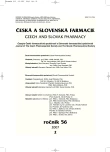Analysis of supplying situation in pharmacies II. Availability of medicaments and health appliances from the viewpoint of the patient
Authors:
B. Macešková; V. Holubková
Authors‘ workplace:
Veterinární a farmaceutická univerzita Brno, Ústav aplikované farmacie
Published in:
Čes. slov. Farm., 2007; 56, 95-97
Category:
Original Articles
Overview
In two pharmacies a survey was carried out to find what medicaments and health appliances are not immediately available for dispensation on presenting a medical prescription or a voucher for a therapeutic or orthopaedic aid. The data for 2005 were subjected to frequency analysis. In pharmacy A (in a community of up to 400 000 inhabitants), mass-produced medicaments were ordered on presentation of 488 medical prescriptions, in pharmacy B (in a community of up to 10 000) it was 3 911 documents (prescriptions and vouchers). There exist no rules for ordering in the PC systems. The total value of ordered preparations in pharmacy A was 195 023.19 CZK (390 different preparations), in pharmacy B, 2 086 209.61 CZK (871 mass-produced preparations and health appliances). Medicaments not available for dispensation when required were repeatedly the identical ones; in pharmacy A, 74 different mass-produced preparations were ordered at least twice a year, in pharmacy B, 797. These preparations were prescribed in pharmacy A in 5.12 % of cases by the same physician, in pharmacy B in 13.92 % of cases also by the same physician. In pharmacy A, all required preparations were collected by the patients; in pharmacy B, uncollected mass-produced preparations valued at 22 947.89 CZK (39 prescriptions, i.e., 1.07 %). More consistent use of the possibilities of automatic proposal of the order and more effective communication with the prescribing physicians could reduce the number of patients who have to wait for their preparation, and thus increase compliance.
Key words:
delayed dispensation – uncollected prescriptions – compliance
Labels
Pharmacy Clinical pharmacologyArticle was published in
Czech and Slovak Pharmacy

2007 Issue 2
Most read in this issue
- Hypericin and hyperforin: bioactive components of St. John’s Wort (Hypericum perforatum) Their isolation, analysis and study of physiological effect
- Pellets preparation by the drug layering technique in a rotary processor
- An orientational examination of the effects of extracts from mixtures of herbal drugs on selected renal functions
- Antioxidants, free radicals, mechanism of action and application in the therapy of the sulfur mustard caused injury
